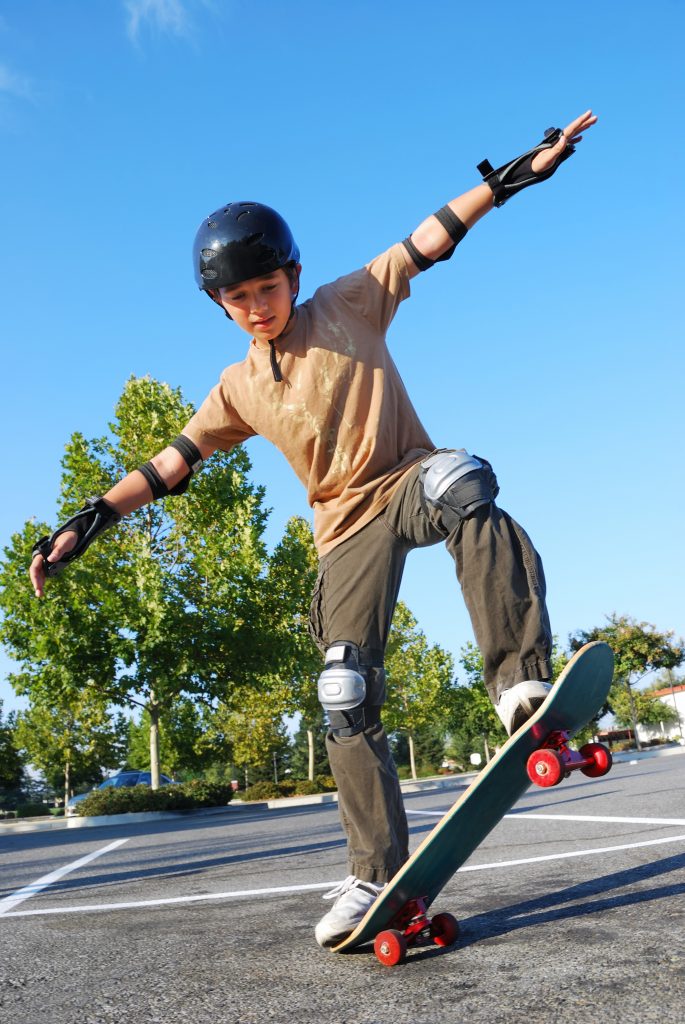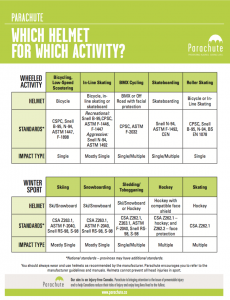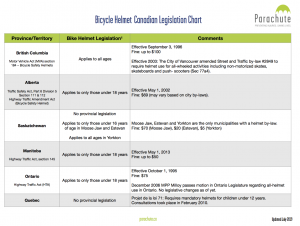Bike helmets can also be used for inline skating and scooter riding. Skateboarding has a different, special helmet.
Using bicycle helmets reduces head injuries by more than 40 per cent, serious head injuries by 60 per cent and traumatic brain injury by 53 per cent. Helmet use reduces the total number of killed or seriously injured cyclists by 34 per cent.
Helmet fitting
Use the right helmet size
- Helmets come in a variety of sizes. There are special helmets for toddlers (under age five) that provide more protection at the back of the head. Some children may outgrow the “toddler” size helmet before age five and should use a bigger helmet.
- Helmets come with extra padding that can be added to the inside of the helmet at the front or the back of the helmet so that it fits correctly.
Check if the helmet is fitting correctly

Shake your head from side to side and from front to back. The helmet should not move around.
Properly fit a helmet
- The helmet should cover the top of the forehead and should rest about two fingers’ width above the eyebrows.
- Side straps should fit snugly around each ear in a “V” shape.
- Buckles on the side strap should fit right under the ear. Buckle the chin strap. Tighten it until you can fit only one finger between the strap and your chin.
- Check the helmet fit every time.
Don’t wear baseball hats under a helmet
- Baseball hats, toques, big hair clips and headphones should never be worn under a helmet.
- Ponytails should be worn low on the neck when wearing a helmet.
- If you wear a hijab, carefully adjust your helmet’s fit to be sure the helmet doesn’t move around when worn on top of the fabric.
- There are now certified helmets available for children who wear their hair knotted on top of their head, such as when wrapped in a patka.
Helmets that are safe to use
Helmet replacements
- Bike helmets should be replaced after five years or a crash where the cyclist has hit their head.
- After five years, the plastics of the helmet dry out and may become brittle with age.
- Older helmets may not meet current safety standards.
- Bike helmets are designed to protect your head against only one crash. After a crash in which the cyclist has hit their head, the foam inside the helmet is compressed. The helmet should be replaced, even if it does not look damaged.
It’s not safe to use a second-hand helmet
It is not a good idea to buy a helmet second-hand. You may not know if the helmet has been in a crash and you may not know how old the helmet is.
Don’t use a helmet with missing parts
You should never use a helmet that has missing parts. Make sure that all of the straps, adjusters and fasteners on the helmet are secure and are in working order. If the sliders or buckles on the side straps are loose, the helmet will not fit correctly and should not be worn.
Don’t put stickers on a helmet
- Every sticker has some type of adhesive to hold it on and adhesives have solvents in them that aid the sticking process. These solvents may make the plastic of the helmet weak.
- Only allow your child to put stickers on their helmet if you know the adhesive is compatible with the plastic of the helmet. If you don’t know, it’s better not to put the stickers on the helmet.
Helmets for different activities
Skateboarding
You need a helmet specially designed and built for skateboarding because skateboarding helmets cover more of the back of the head and will protect against more than one crash. Because falls are common in skateboarding, these helmets are made of material that is specially designed to withstand multiple impacts on the same spot.

Non-motorized scooter riding: helmets and equipment
- You can use bike helmets or multi-sport helmets that have been tested for scooter riding.
- The use of wrist guards is not recommended as they can interfere with steering and cause injuries.
- Elbow pads and knee pads may also protect from injuries, but there is very little research to show that they are effective.
Multi-sport helmet
A multi-sport helmet is a helmet that meets safety standards for more than one activity. Be sure the multi-sport helmet shows clearly what activity it has been tested for. If you have any questions, contact the manufacturer.


